
The Victor-Victrola Page

VV-XVII / VE-XVII
RARITY: ¤¤ VALUE: ¤¤¤

The
VV-XVII or "Victrola the Seventeenth" was Victor's 'premium' phonograph
listed in the company's 1916-1921 product catalogs. A year prior to its
introduction, Victor had
launched the magnanimous VV-XVIII as their top-of-the-line Victrola retailing for $300.00,
which was $100.00 more than the VV-XVI 'flagship' model. This was an attempt to
find a market 'niche for wealthy buyers who wanted an exceptionally elegant
phonograph in their home. Sales of the XVIII were far slower than
expected; it was reduced in price and removed from the catalog one year later. The perception at Victor Headquarters may have been that the
XVIII was just too expensive for most buyers. However,
 another important consideration may have been missed; beginning in 1914, the
buying public's preferences had been slowly drifting away from high-end premium
machines. The vast array of new and relatively inexpensive Victrolas (which
performed and sounded identically to the high-price machines) were now becoming
commonplace in homes. Therefore, ownership of a super-expensive phonograph no
longer had the same degree of 'elite-appeal' as had been the case just a few
years earlier when Victrolas were still considered to be unusual and elegant
furnishings for wealthy buyers.
another important consideration may have been missed; beginning in 1914, the
buying public's preferences had been slowly drifting away from high-end premium
machines. The vast array of new and relatively inexpensive Victrolas (which
performed and sounded identically to the high-price machines) were now becoming
commonplace in homes. Therefore, ownership of a super-expensive phonograph no
longer had the same degree of 'elite-appeal' as had been the case just a few
years earlier when Victrolas were still considered to be unusual and elegant
furnishings for wealthy buyers.
Introduced in the fall of 1916 as a lower-cost replacement for the
discontinued XVIII, the new VV-XVII was certainly an elegant and impressive machine, but
markedly less ornate than its high-end predecessor. While it did share
the bombe' style curved cabinet and nicely carved corner posts, the overall size
was further reduced and the beaded trim on the doors was removed. The XVIII's exclusive
cross-hatched veneers were replaced with nicely-figured brown or red mahogany.
The base price of the XVII was set at $250.00, which equates to almost $6,000.00 in today's
money.
As was the case with the XVIII, a number of appearance options were available;
finishes in Circassian or American Walnut (left) added $50.00 to the price tag;
a gold Vernis Martin finish (as was available on the VV-XVI and XVIII models)
would double the list price; in addition, a few highly exotic finishes were
produced, including "Japanese Lacquer" (right), which consisted of a glossy
black lacquer coating with
ornate oriental decals applied.
An electric motor option (designed as "VE-XVII") was also available, adding
$50.00 to the list price.
The new XVII was certainly a beautiful Victrola, but did not
quite measure-up in quality or detail to the exquisite XVIII which it had
replaced.
While the production output of the XVII was much higher than the earlier XVIII,
the overall success of this new high-end Victrola was marginal. The high
price was certainly a contributing factor; a very nice, full-size VV-XVI could
be had for $50.00 less, and by 1919, the catalog list price of
the XVII had risen to $300.00, which was the same cost as the discontinued (and
'too-expensive') VV-XVIII of just a few years earlier. Plus, the trend away from
high-end machines and toward more 'popular' models continued to limit sales.
While a total of approximately 20,700 VV-XVII machines were manufactured, this
turned-out to be more than could be sold in the near-term. Many remained sitting
in factory inventory waiting for orders. While production of cabinets for the
XVII got off to a roaring start, output had slowed markedly upon the onset of
the US involvement in World War One (April 1917); but per Robert Baumbach's "Victor Data Book",
the shipping summaries indicate that as of mid-1918, the factory had shipped
only 12,000 complete VV-XVII models, likely leaving about 8,700 cabinets stocked-away in plant
storage waiting to be finished, assembled and ordered. This remaining inventory then slowly 'trickled out' to dealers well
into 1921.
A total of just over 2,500 electric motor versions (VE-XVII) were made, all
produced during 1916 and 1917.
The survival database
currently shows the earliest existent VV-XVII to be S/N 504 and the latest to be
S/N 21227
The earliest logged VE-XVII survivor is S/N 539 and the latest is S/N 2965
| Manufacture Date | Approximate Serial Number Range | Feature Notes |
| 1916 | 501-3500 | Initially launched with "Exhibition" Soundbox. |
| 1917 | 3501-12000 | Updated to "fat" tonearm and "No. 2" Soundbox late in year |
| 1918 | 12001-21300 | Some likely produced as 'empty cabinets' to be finished and sold at a later date. Special "Japanese Lacquer" versions produced between s/n 15000 and 15139 |
| VE-XVII Electric: | ||
| 1916 | 501-1100 | Initially launched with "Exhibition" Soundbox. |
| 1917 | 1101-3040 | "Fat" tonearm and No. 2 Soundbox introduced late in year |
Do you own a Victrola VV-XVII? Please take a moment and enter some basic information about your machine into the collector's database by clicking here. No personal information is required.